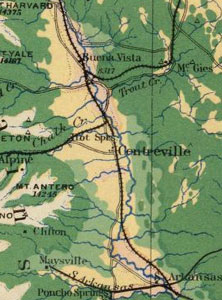 |
| current status |
| mission & introduction |
| goals & objectives |
| wildfire hazard maps |
| fire resource list |
| grant opportunities |
| CWPP guidelines |
|
|
Web hosting donated by Colorado Firecamp.
| Community Wildfire Protection Plan | ||||||
| Chaffee County, Colorado | ||||||
| goals and objectives | ||||||
Goals and ObjectivesChaffee County experiences frequent high winds, dry conditions, lightning storms, and heavy use of wildlands by residents and visitors alike, which can all lead to destructive wildfires. The fire does not have to be very large to cause significant damage. This countywide plan is intended as a first step in the wildfire mitigation planning process. The following are the broad goals and specific objectives of the Chaffee County Community Wildfire Protection Plan: A. Planning and CollaborationGoal: Create a “living” flexible document that incorporates a multi-agency approach to planning. The CWPP incorporates input from all the stakeholders in the
County. These include the local citizens, representatives from
selected subdivisions, the two Fire Protection Districts, as
well as the Federal Land Management Agencies (US Forest Service
and Bureau of Land Management), the Colorado State Forest Service,
and Chaffee County Government, Emergency Services, and Sheriff’s
Office. This collaboration will provide a multi-jurisdictional
approach to strategic planning, and improve fire suppression
and fuel treatment efficiencies on public and private lands.
B. Public Safety and AwarenessGoal: Promote and develop materials and programs in prevention and education that improve community wildfire awareness and safety. The CWPP provides a forum for the coordination of public meetings, discussion groups, and public information campaigns to create awareness within Chaffee County about wildfire danger and to create action to mitigate hazards on both public and private lands, and improve prevention and preparedness.
C. Fuels ReductionGoal: Facilitate appropriate hazardous fuel reduction by illustrating the areas of greatest wildfire hazard and developing the highest priorities for fuels abatement treatments. The CWPP displays the relative levels of wildfire hazard in the County, both private and public, and selects the highest priority areas for land management agencies to focus their fuels treatment activities on public lands. Also, the identification of the highest areas of concern will improve multi-jurisdictional pre-suppression planning and facilitate the implementation of cross boundary projects.
|
||||||